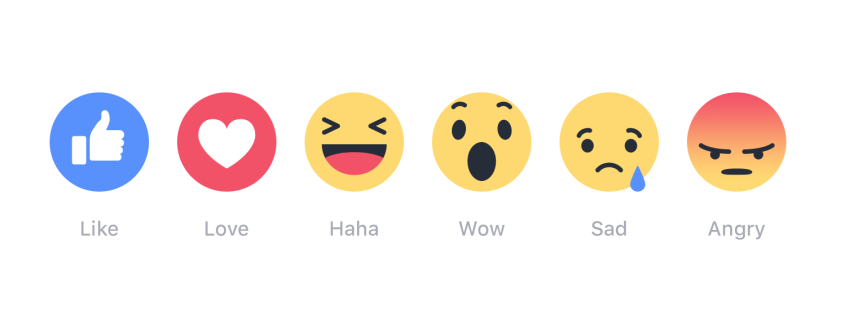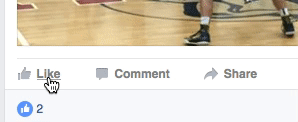Facebook releases Reactions feature
Facebook has added five new Reaction options in addition to being able to “like” posts. The feature was released worldwide on Feb. 24.
March 6, 2016
Facebook released Reactions worldwide on Feb. 24, adding options for “love, haha, wow, sad or angry” to the traditional “like” and “comment” features.
“Not every moment you want to share is happy. Sometimes you want to share something sad or frustrating,” Facebook CEO Mark Zuckerberg said in a Facebook post. “Our community has been asking for a dislike button for years, but not because people want to tell friends they don’t like their posts. People wanted to express empathy and make it comfortable to share a wider range of emotions.”
This global implementation followed a limited release of the emoticons last year, which Facebook used as a trial period to receive feedback about the changes, which according to their press release, was positive overall. Facebook has also been testing out the buttons with research groups and surveys to determine the best array of reaction options.
Users can hover over the “like” button on desktop computers and hold down the button on mobile devices to see the new reaction options. Mark Zuckerberg stated in a Facebook post that the company’s goal was to insert the reaction buttons and to be able to use them in the simplest way possible.
“They did a very good job with making it smooth, but I think it might overcomplicate things,” Amy Dunphy (10) said. “Now it’s kind of a struggle — which one do I put, do I just put a normal “like” [and] is that socially acceptable?”
All posts now show the total number of reactions, rather than likes, as well as the three most popular reactions and their respective total tallies.
“It’s a great way to express your feelings for the photo and not just a like button because you could feel different emotions towards the photo, like if you love it or you think it’s really funny. I think it’s a really good [idea],” Taylor Lam (9) said.
Facebook has stated that the new options will give advertisers and posters additional insight into their audience’s viewpoints and opinions.
Although Facebook’s news feed algorithms currently treat all reactions as the same when prioritizing posts, Product Manager Sammi Krug announced in a Facebook blog post that the company hopes to eventually develop an algorithm that recognizes differences in users’ reaction choices to improve the relevance of posts in users’ news feeds.


















![“[Building nerf blasters] became this outlet of creativity for me that hasn't been matched by anything else. The process [of] making a build complete to your desire is such a painstakingly difficult process, but I've had to learn from [the skills needed from] soldering to proper painting. There's so many different options for everything, if you think about it, it exists. The best part is [that] if it doesn't exist, you can build it yourself," Ishaan Parate said.](https://harkeraquila.com/wp-content/uploads/2022/08/DSC_8149-900x604.jpg)




![“When I came into high school, I was ready to be a follower. But DECA was a game changer for me. It helped me overcome my fear of public speaking, and it's played such a major role in who I've become today. To be able to successfully lead a chapter of 150 students, an officer team and be one of the upperclassmen I once really admired is something I'm [really] proud of,” Anvitha Tummala ('21) said.](https://harkeraquila.com/wp-content/uploads/2021/07/Screen-Shot-2021-07-25-at-9.50.05-AM-900x594.png)







![“I think getting up in the morning and having a sense of purpose [is exciting]. I think without a certain amount of drive, life is kind of obsolete and mundane, and I think having that every single day is what makes each day unique and kind of makes life exciting,” Neymika Jain (12) said.](https://harkeraquila.com/wp-content/uploads/2017/06/Screen-Shot-2017-06-03-at-4.54.16-PM.png)








![“My slogan is ‘slow feet, don’t eat, and I’m hungry.’ You need to run fast to get where you are–you aren't going to get those championships if you aren't fast,” Angel Cervantes (12) said. “I want to do well in school on my tests and in track and win championships for my team. I live by that, [and] I can do that anywhere: in the classroom or on the field.”](https://harkeraquila.com/wp-content/uploads/2018/06/DSC5146-900x601.jpg)
![“[Volleyball has] taught me how to fall correctly, and another thing it taught is that you don’t have to be the best at something to be good at it. If you just hit the ball in a smart way, then it still scores points and you’re good at it. You could be a background player and still make a much bigger impact on the team than you would think,” Anya Gert (’20) said.](https://harkeraquila.com/wp-content/uploads/2020/06/AnnaGert_JinTuan_HoHPhotoEdited-600x900.jpeg)

![“I'm not nearly there yet, but [my confidence has] definitely been getting better since I was pretty shy and timid coming into Harker my freshman year. I know that there's a lot of people that are really confident in what they do, and I really admire them. Everyone's so driven and that has really pushed me to kind of try to find my own place in high school and be more confident,” Alyssa Huang (’20) said.](https://harkeraquila.com/wp-content/uploads/2020/06/AlyssaHuang_EmilyChen_HoHPhoto-900x749.jpeg)








